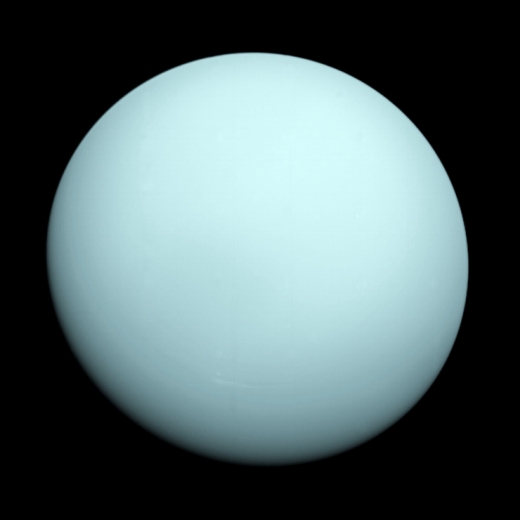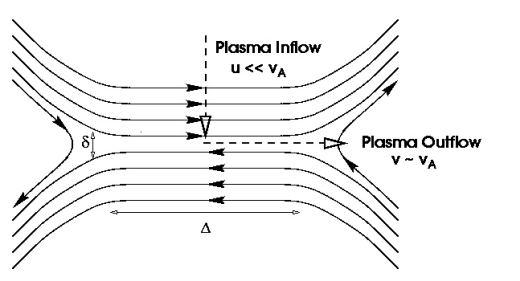Perhaps the image of Uranus just below helps explain why the planet has been treated so sparsely in science fiction. Even this Voyager view shows us a featureless orb, and certainly in visible light the world has little to make it stand out other than its unusual axis of rotation, which is tilted so that its polar regions are where you would expect its equator to be. Geoff Landis’ “Into the Blue Abyss” (2001) is the best fictional treatment I know, but the fog-shrouded Uranus of Stanley G. Weinbaum’s “The Planet of Doubt” (1935) has its own charms, though obviously lacking the scientific verisimilitude of the Landis tale.
My admiration for Gerald Nordley’s “Into the Miranda Rift” (1993) is unabated, taking us into this strange world’s most dramatic moon, while I should also mention Kim Stanley Robinson’s visit to Uranus in Blue Mars (1997), where the moon is established as a protected wilderness site while the rest of the Uranian satellite system is under colonization. Fritz Leiber’s “Snowbank Orbit” (1962) explores aero-braking at Uranus, while Larry Niven’s A World Out of Time (1976) maneuvers the planet to adjust the Earth’s own orbit.

Image: The planet Uranus as seen by Voyager 2, which flew closely past the seventh planet in January of 1986. Credit: NASA/JPL.
I will spare you the 1962 film Journey to the Seventh Planet and move on to new work on Uranus out of the Georgia Institute of Technology, where researchers have discovered that the magnetosphere of the planet ‘flips on and off like a light switch’ (according to this Georgia Tech news release) as it rotates along with the planet. In one orientation, the solar wind flows into the magnetosphere, which later closes to deflect that same wind away from Uranus.
Rotating on its side, Uranus also has a magnetic field that is off-centered and tilted 60 degrees from its axis of rotation. What we wind up with is rapid rotational reorientation, keeping the field strength turbulent. Carol Paty (Georgia Tech), a co-author of the study, puts the matter this way:
“Uranus is a geometric nightmare. The magnetic field tumbles very fast, like a child cartwheeling down a hill head over heels. When the magnetized solar wind meets this tumbling field in the right way, it can reconnect and Uranus’ magnetosphere goes from open to closed to open on a daily basis.”
Compare this with the Earth, where the magnetic field is nearly aligned with the planet’s spin axis, which means that the magnetosphere spins along with the Earth’s rotation. Even so, disruptive events can occur because of geomagnetic storms. A strong solar storm disrupting the magnetic fields of the solar wind can reconfigure Earth’s field from closed to open, rearranging the local magnetic topology to allow a surge of solar energy to enter the system. Such reconnection happens throughout the Solar System, and occurs when the direction of the heliospheric magnetic field is opposite to a planet’s magnetospheric alignment.
Geomagnetic storms produced by coronal mass ejections slamming into Earth’s magnetic field can produce spectacular aurora events while playing havoc with radio communications. Reconnection drives the entire process, happening in the presence of plasma, which carries its own magnetic fields in a constantly adjusting dance between charged particles and fields. Sudden changes in the alignment of the magnetic field lines convert the stored energy of the magnetic fields into heat and kinetic energy that drives particles along the field lines.

Image: Magnetic reconnection (henceforth called “reconnection”) refers to the breaking and reconnecting of oppositely directed magnetic field lines in a plasma. In the process, magnetic field energy is converted to plasma kinetic and thermal energy. Credit: Magnetic Reconnection Experiment.
Thus a surge of energy enters the system. Such magnetic reconnection should produce auroras at various latitudes on Uranus even if they are a challenge to observe from Earth. The Georgia Tech team’s numerical models predict the most likely places on the planet for reconnection, working with Voyager 2 data from the 1986 flyby. Lead author Xin Cao comments:
“The majority of exoplanets that have been discovered appear to also be ice giants in size. Perhaps what we see on Uranus and Neptune is the norm for planets: very unique magnetospheres and less-aligned magnetic fields. Understanding how these complex magnetospheres shield exoplanets from stellar radiation is of key importance for studying the habitability of these newly discovered worlds.”
The paper is Cao and Paty, “Diurnal and seasonal variability of Uranus’s magnetosphere,” published online by the Journal of Geophysical Research: Space Physics 27 June 2017 (abstract).



Uranus also has a magnetic field that is off-centered and tilted 60 degrees from its axis of rotation.
IIRC, Neptune has a magnetic field almost as wonky as Uranus’s. Is there some reason Ice Giants would have such magnetic fields?
It could be due to the higher ionic conductivity of their icy mantles than their cores which would most likely be very hot suppressing magnetic field generation.
A NASA Science definition team has been looking at mission options to the Ice Giants. For Uranus, thus includes Flybys, done already by Voyager 2 , and a variety of increasingly comprehensive orbiters . The basic , 3 instrument 50 Kg payload comes in at $1.6 billion , with an extra $400 million adding in an atmospheric Probe. The most sophisticated 150 Kg payload includes a comprehensive 11 instruments ( including a magnetometer ) and comes in at up to $2.4 billion , but without an additional Probe. Launched by Atlas V or Delta IV Heavy gives transfer times of around ten years with a Jupiter Gravity assist ( possibly with Earth and Venus involved additionally ) with multiple launch Windows available between 2028 and 2032. ( Saturn also available ) The SLS plus or minus SEP staging can reduce transfer times by two- three years. As yet untried atmospheric aerobreaking can bring transfer down even more to as low as just 5 years.
All on the Outer Planets Assessment Group ,OPAG , NASA site and well worth a read . Plenty of Neptune options too generally at an additional $300 million cost per option and transfer times varying from 13 years down to just 7 with aero breaking .
See also this new article from the great blog Future Planetary Exploration:
http://futureplanets.blogspot.com/2017/06/how-we-would-explore-uranus-or-neptune.html
Good to see NASA is considering some ice giant orbiters and atmospheric probes.
I assume the ice giants being gas giants have magnetic fields for the same reasons as other larger gas giants like Jupiter and Saturn: Electric arcs caused by the coriolis deflection of liquid metallic hydrogen make the magnetic field. Pressure ionization is what happens when hydrogen is under great pressure. The hydrogen becomes a conductor of electricity like a metal. The electrons become more free like the conduction band of a metal.
Paul, you wrote “titled” instead of “tilted” in the second sentence. (Please feel free to delete this comment after you’ve read it.)
Fixed. Thanks for catching that, Jon, and always feel free to let me know such things. I appreciate it when readers catch such gaffes.
Our friend the atom would make such outer solar system missions practical in terms of transit times, power for onboard instruments and radio equipment, and payload mass for things such as atmospheric probes and/or satellite landers. This 1980s Los Alamos/NASA Neptune orbiter/probe design (see pages 83 – 86 here: http://books.google.com/books?id=mQAAAAAAMBAJ&pg=PA83&lpg=PA83&dq=Popular+Science+nuclear+ion+drive+Neptune+probe&source=bl&ots=jkvETpyUxy&sig=O1Pjf50uG6ABrgN5rgVVlw0p87A&hl=en&sa=X&ved=0ahUKEwir9vbgkODUAhVN9mMKHdIIAfsQ6AEIJTAA#v=onepage&q=Popular%20Science%20nuclear%20ion%20drive%20Neptune%20probe&f=false ) shows what could have been done 30+ years ago; imagine what could be done using *today’s* space reactor, ion drive (or Hall Effect thruster), and electronics technologies? I heartily agree with what David Buden and Joseph A. Angelo Jr. said in their XXXII International Astronautical Congress paper (in 1981) that is referenced in the above-linked June 1984 “Popular Science” article:
“…the development of advanced space nuclear-power systems…is a critical technology step in the humanization of space. Without space nuclear power…man rejects his ultimate role in the cosmic scheme of things. With the energy of the atomic nucleus humanity can continue on its journey to the stars!” Also:
Even by the mid-1960s, space reactor technology (including thermionic power conversion) was well advanced. As “Centauri Dreams” contributor Andrew J. LePage has documented (see: http://www.drewexmachina.com/2015/04/03/50-years-ago-today-the-first-nuclear-reactor-in-orbit/ ), the U.S. launched a nuclear reactor into Earth orbit in April 1965. The Snapshot mission involved the SNAP-10A reactor, which powered onboard instruments and a small cesium-fueled ion engine; more powerful reactors such as the SNAP-50 were under development to power space stations, lunar bases, and electrical propulsion spaceships for exploring the solar system (see: http://www.osti.gov/includes/opennet/includes/Understanding%20the%20Atom/Nuclear%20Reactors%20for%20Space%20Power.pdf and http://www.osti.gov/includes/opennet/includes/Understanding%20the%20Atom/SNAP%20Nuclear%20Space%20Reactors.pdf ).
Based on some recent news out of the White House, it sounds as though we finally have an administration which is both pro-space AND pro-nuke. Promising!
Huge Storm Observed On Neptune
Press Release – Source: UC Berkeley
Posted August 3, 2017 9:35 PM
http://spaceref.com/neptune/huge-storm-observed-on-neptune.html
To quote:
“Historically, very bright clouds have occasionally been seen on Neptune, but usually at latitudes closer to the poles, around 15 to 60 degrees north or south,” said Imke de Pater, a UC Berkeley professor of astronomy and Molter’s adviser. “Never before has a cloud been seen at or so close to the equator, nor has one ever been this bright.”
At first, de Pater thought it was the same Northern Cloud Complex seen by the Hubble Space Telescope in 1994, after the iconic Great Dark Spot, imaged by Voyager 2 in 1989, had disappeared. But de Pater says measurements of its locale do not match, signaling that this cloud complex is different from the one Hubble first saw more than two decades ago.
How many science fiction stories ever imagined a world where it rained diamonds – in the planet’s interior?
http://www.lightsources.org/press-release/2017/08/21/scientists-create-%E2%80%98diamond-rain%E2%80%99-forms-interior-icy-giant-planets
Cosmic Crash That Knocked Uranus Sideways Also Made Its Moons
https://www.space.com/39123-crash-that-tilted-uranus-made-moons.html